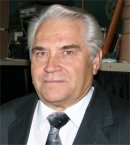|
Plenary
Lecture
Adequate Modeling of Fluid Flows

Professor Yuli
D. Chashechkin
Laboratory of Fluid Mechanics
Institute for Problems in Mechanics of the
Russian Academy of Science
101/1 prospect Vernadskogo, Moscow, 119526 RUSSIAN
FEDERATION
E-mail:
chakin@ipmnet.ru
Abstract: For definition of adequate analytical and
laboratory modeling of fluid flows conditions the
conventional fundamental governing equations set is
analyzed thoroughly. The basic equation in this approach
is a state equation defining a number of thermodynamic
variables which are necessary to characterize properties
of particular medium and flow conditions. The total
fundamental set of governing equations consisting of
state, continuity and transport of momentum, temperature
and constituent component equations is treated as
singular disturbed system. Dissipative properties of the
fluid are characterized by kinematic viscosity,
temperature and diffusivity coefficients of constituent.
General solutions of the linearized governing equations
sets consist of regular and singular disturbed on
dissipative factors functions. All flow components are
characterized by their scales. Regular disturbed
solutions (redics) of the set describe waves and
vortices. Rate of their dissipation is proportional to
viscosity and other kinetic coefficients. In limiting
case redics are matched continuously with solutions of
appropriate Euler equations set. Rich family of singular
disturbed functions (sidics) describes fine flow
components. Sidics transverse length scales are defined
by dissipative factors and intrinsic frequencies of the
problem that are by frequency of buoyancy (or rotation)
in stratified (or vortex) flows. Besides boundaries the
fine flow components manifest themselves inside the
fluids as interfaces. The sidics are responsible for
energy dissipation, production and transport of
vorticity and anisotropic transport of contaminants. In
general non-linear description all flow components
interact between themselves directly in spite of the
scales differences. Illustrative experimental
investigations of 2D and 3D periodic internal wave
beams, lee waves and wakes past uniformly moving
obstacles in a continuously stratified fluid were
performed in laboratory tanks using markers, schlieren
instruments and conductivity sensors. Restructuring of
interfaces and their transformation into vortices and
vortex systems were registered far from the solid
boundaries directly inside the continuously stratified
fluid. New structural elements that are "tubular
structures" were visualized in the periodic internal
wave beams. Extended singular components accumulate
contaminants and provide their fast transport. Strong
anisotropy of a dye transport in a stationary compound
vortex motion produced by uniformly rotating disc in
cylindrical container was observed. Spiral arm was
spinning from a dye drop put into center of surface
trough produced by compound vortex. Set of all flow
scales ratios form conditions of adequate laboratory
modeling. Extrapolation of model data on environmental
and technical conditions is discussed.
Brief Biography of the Speaker:
Yuli D. Chashechkin is head of the Laboratory of Fluid
Mechanics of the A.Yu.Ishlinski Institute for Problems
in Mechanics of the Russian Academy of Sciences and
professor of Physical Faculty of M.V.Lomonosov Moscow
State University. His main research interests concern
foundations of fluid mechanics, theory of stratified and
rotating flows, optical visualization of fluid flows. In
these fields, he authored or co-authored over 200
scientific papers published in reviewed journals or
presented at international conferences. Well known his
schlieren images of internal waves, convective flows,
vortices and wakes. As invited research professor he
visited and worked in a number of Western and Eastern
Universities including Arizona State University (USA),
Ecole Normale Superior (Paris, France), The Tokyo
University (Japan), University Toulon-Sud (France),
University Polytechnic Catalonia (Barcelona, Spain) and
others. He took part in a number of national and
international marine cruises for studying marine
turbulence, fine structure and internal waves. He is
European regional editor of Journal of Visualization,
organizers of biannual conferences on Fluxes and
Structures in Fluids and co-editor of their Selected
Papers Volumes.
|
